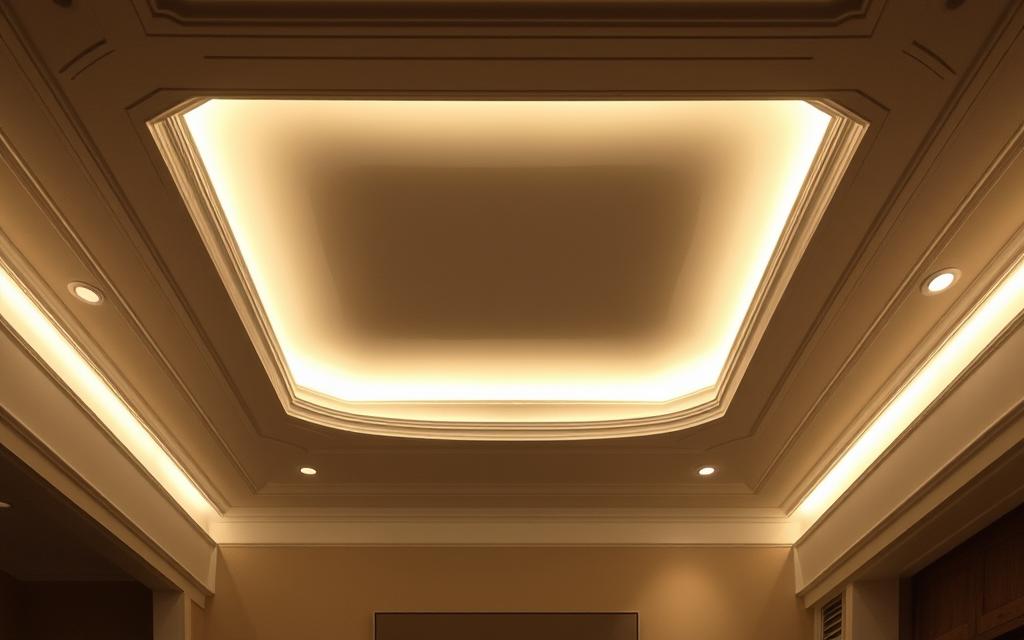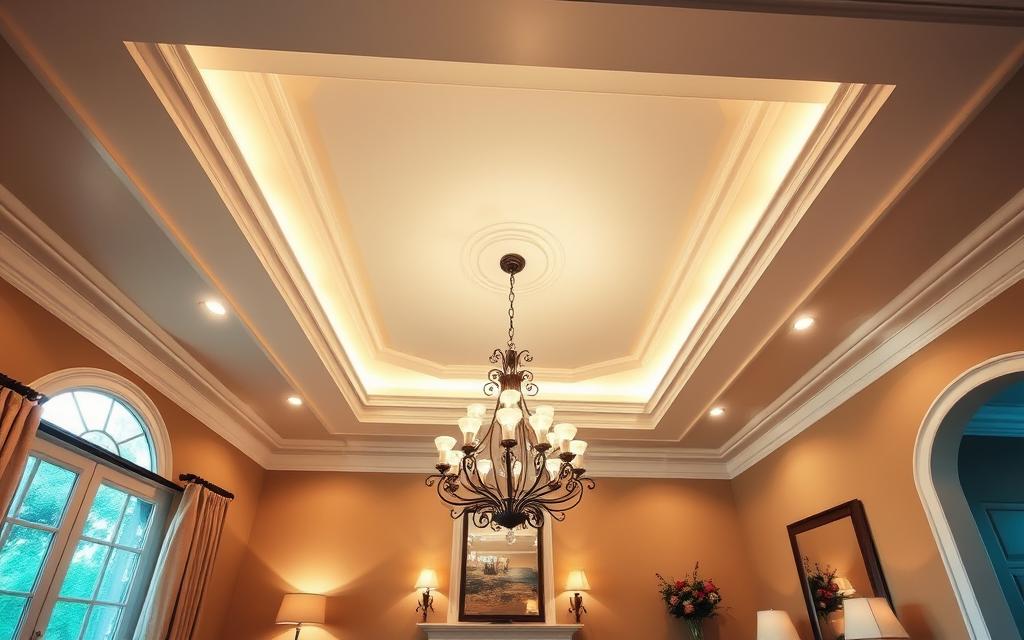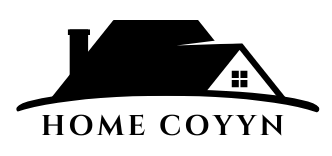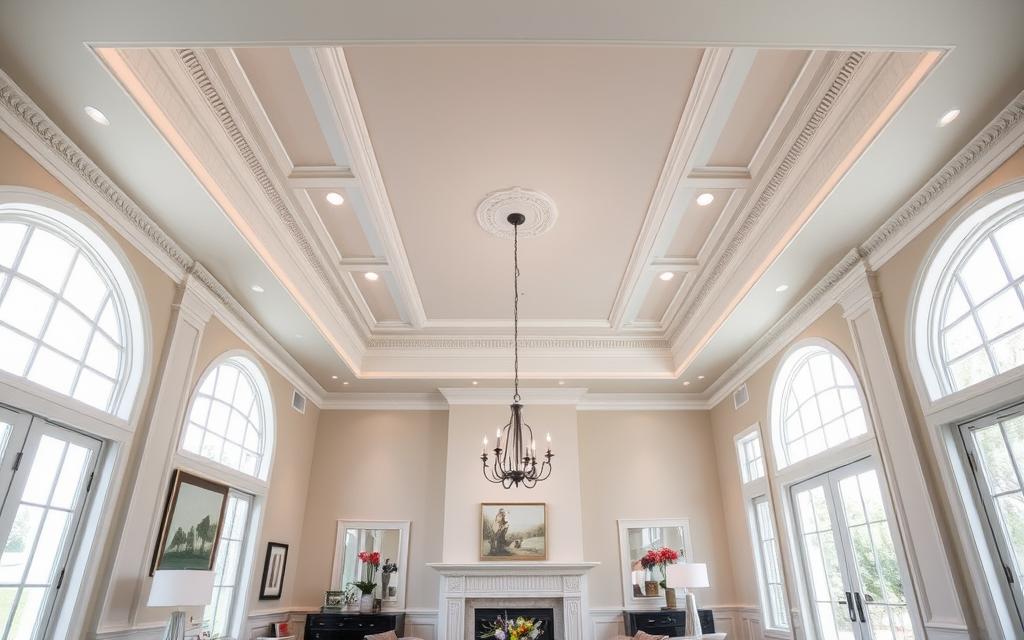The tray ceiling has become a key feature in interior design. It changes how your home looks and feels. This article will show you how tray ceilings can make your living spaces look more elegant and sophisticated.
Key Takeaways
- Tray ceilings are a type of recessed ceiling that creates visual depth and a sense of grandeur in a room.
- Tray ceilings have their roots in classical architectural styles and can be found in various design variations.
- Tray ceilings offer numerous benefits, including enhanced visual interest, a heightened sense of space, and a more luxurious ambiance.
- Incorporating tray ceilings into different rooms, such as living rooms and bedrooms, can transform the overall look and feel of your home.
- Proper construction, lighting, and integration with other architectural elements are crucial for achieving the desired tray ceiling aesthetic.
What is a Tray Ceiling?
A tray ceiling is a design that brings depth and visual interest to a room. It has a raised middle part surrounded by a lower edge, making it look like a stepped or “tray-like” shape. This design comes from classical and Renaissance architecture, aiming to add height and grandeur to important areas.
Definition and Architectural Origins
The tray ceiling is a type of built-up ceiling that lifts the middle part of the room. It started in the 16th and 17th centuries, popular in stately homes and palaces. This design makes the room feel bigger and more luxurious with its tiered effect.
Distinguishing Features and Variations
Tray ceilings stand out with their layered look, often framed by decorative moldings. The tray’s depth can be small or quite deep, adding to its unique effect. To make it even more striking, you can use different colors, finishes, or lighting to highlight the design.
Tray ceilings can be mixed with other design elements like beams or coffered ceilings for a unique look. This ceiling style is great for many rooms, including living areas, bedrooms, and dining rooms. Its versatility makes it a favorite among homeowners and designers.
Benefits of Tray Ceilings
Tray ceilings are more than just a pretty face. They bring both beauty and practical benefits to a room. They add depth and make a room look more impressive. Plus, they can highlight special design features, making any home look better.
Enhancing Visual Interest and Depth
A tray ceiling makes a room seem taller and deeper. The recessed center pulls your eyes up, showing off the design details. This trick works well with vaulted ceilings, recessed ceilings, or coffered ceilings, adding to the room’s grand feel.
Creating a Sense of Grandeur
Tray ceilings bring a touch of luxury and elegance to a space. The raised center and border make a room feel more sophisticated. This look is perfect for formal areas like living rooms, dining rooms, or even master bedrooms, adding a special touch.
Using tray ceilings can make your home more interesting and spacious. They add depth and a sense of grandeur, improving your home’s look and feel.
Tray Ceiling Design Inspiration
Tray ceilings add a unique and captivating look to any room. They can make your living room look more elegant or your bedroom cozy and inviting. The design options for tray ceilings are endless.
In the living room, a tray ceiling brings grandeur and sophistication. Think about a traditional tray ceiling with detailed molding and a shiny finish for a classic look. Or, go for a modern, simple tray ceiling with clean lines and a matte finish for a contemporary feel.
For bedrooms, a tray ceiling becomes a beautiful focal point. It makes the room seem taller and deeper. A vaulted tray ceiling with soft lighting creates a cozy yet luxurious vibe. Adding a tray ceiling with a different paint color or metallic accents brings drama and interest.
Tray ceilings work well in dining rooms, entryways, and bathrooms too. They add elegance and sophistication. Try out different styles, materials, and finishes to match your unique design vision.
| Tray Ceiling Style | Ideal Room | Design Inspiration |
|---|---|---|
| Traditional Tray Ceiling | Living Room | Intricate molding, satin or glossy finish |
| Modern Tray Ceiling | Living Room | Clean lines, matte finish |
| Vaulted Tray Ceiling | Bedroom | Subtle lighting, cozy and luxurious feel |
| Contrasting Tray Ceiling | Bedroom | Contrasting paint color or metallic accents |
Incorporating Tray Ceilings in Different Rooms
Tray ceilings can make any room look better, from the big living room to the small bedroom. They add a special touch to the design. Homeowners can use them to make their spaces look amazing.
Living Room Tray Ceiling Ideas
A tray ceiling in the living room adds elegance and grandeur. It draws the eye up, showing off the room’s details. Adding recessed lighting or special moldings can make it even better.
Using a paint color that stands out can also make the ceiling pop. This turns the living room into a place that looks refined and classy.
Bedroom Tray Ceiling Designs
Tray ceilings can turn the bedroom into a luxurious retreat. The raised center makes the room feel bigger and airier. The lower parts add a cozy touch.
Homeowners can choose from different designs, like a vaulted tray ceiling or a classic recessed one. This lets them match the ceiling with their bedroom’s style.
| Tray Ceiling Type | Living Room Application | Bedroom Application |
|---|---|---|
| Recessed Tray Ceiling | Enhances architectural details, creates a sense of grandeur | Adds an airy, luxurious feel, can make the room feel more spacious |
| Vaulted Tray Ceiling | Adds visual interest and drama to the living space | Provides a cozy yet elevated ambiance in the bedroom |
Using tray ceilings in living rooms and bedrooms opens up new ways to improve their style and comfort. Whether it’s a recessed or vaulted tray ceiling, this feature can change a room. It adds grandeur, sophistication, and luxury.
Tray Ceiling Construction and Installation
Tray ceilings add beauty and lift to a room. They need careful planning and execution. It’s important for homeowners and contractors to know the materials and methods used.
Materials and Techniques
Building a tray ceiling involves several steps. First, the frame is set up with lumber or metal studs for the raised section. Then, drywall covers the frame for a smooth finish.
The tray ceiling can be painted, textured, or have moldings for extra style. This makes the ceiling stand out.
Considerations for Existing Homes
Adding a tray ceiling to an old house needs extra thought. You might face issues like low ceilings or walls that carry weight. You might need to lower the ceiling or design the tray carefully to fit well.
Installing a tray ceiling might mean taking down drywall or moving wiring and lights. Working with skilled contractors is key for a great architectural ceiling detail and raised ceiling interior.
“The beauty of a tray ceiling lies in its ability to transform a room, creating a sense of grandeur and depth that cannot be achieved with a flat ceiling.”
Tray Ceiling Lighting Options
Tray ceilings have a special design that lets you play with lighting to change the feel of a room. You can make a space warm and welcoming or spotlight its details with the right lighting. Choosing the right lights is key.
Recessed lights are a top pick for tray ceilings. They sit flush with the ceiling, giving a soft, even light that highlights the tray’s design. For more drama, go for dimmable recessed lights to change the brightness as needed.
Pendant lights are great for tray ceilings too. Hanging a big pendant or several smaller ones in the tray draws the eye up. This is perfect for high-ceiling rooms, making them feel even more impressive.
For a touch of elegance, try LED strip lighting around the tray ceiling’s edges. This indirect lighting adds a soft glow, showing off the ceiling’s details and making the space feel cozy.
When picking lights, make sure they’re placed well and balanced. You want a lighting design that looks good with the tray ceiling and improves the room’s feel.

Using these lighting options can turn your tray ceiling into a stunning focal point. It makes the room look better and works well with its design.
Combining Tray Ceilings with Other Architectural Elements
Tray ceilings add elegance and visual interest to any room. They don’t have to be alone. By combining them with other architectural elements, you can make your space look amazing.
Integrating with Beams and Moldings
Adding exposed beams to a tray ceiling can really make it pop. The smooth ceiling contrasts beautifully with the rustic beams. This is perfect for rooms with a traditional or farmhouse look, adding warmth and character.
Or, you could use fancy crown moldings with your tray ceiling. These trimmings add sophistication and make the ceiling stand out. It’s great for formal or luxurious rooms, where the decorative ceiling is the main attraction.
| Design Element | Aesthetic Impact | Suitable Interiors |
|---|---|---|
| Exposed Beams | Adds warmth and character | Traditional, Farmhouse |
| Decorative Moldings | Lends sophistication and grandeur | Formal, Luxurious |
Mixing the tray ceiling with beams and moldings creates a stunning design. You can customize it to fit your style and preferences. The result is a cohesive and visually appealing space.
Tray Ceiling vs. Other Ceiling Styles
Homeowners often look at different ceiling styles, like tray, vaulted, and coffered ceilings. Each style has its own look and benefits. It’s important to know what makes them special.
Vaulted Ceilings: Soaring Grandeur
Vaulted ceilings have an arched or domed shape. This makes a room feel taller and more open. They’re great for big, open rooms because they make the space seem bigger.
Coffered Ceilings: Geometric Elegance
Coffered ceilings have a grid of recessed panels and decorative moldings. They add beauty and a touch of sophistication. Unlike tray ceilings, coffered ceilings focus on the width, making rooms feel wider.
| Ceiling Style | Key Features | Ideal Spaces |
|---|---|---|
| Tray Ceiling | Raised central area with a recessed perimeter | Bedrooms, dining rooms, living rooms |
| Vaulted Ceiling | Arched or domed shape, creating a sense of height | Open-concept living areas, great rooms |
| Coffered Ceiling | Recessed panels arranged in a grid-like pattern | Formal living rooms, dining rooms, home offices |
Knowing what makes each ceiling style unique helps homeowners choose the best one for their home. It matches their architecture and personal taste.

Tray Ceiling Maintenance and Care
Keeping your tray ceiling looking great is crucial for your home’s look. Regular cleaning and fixing any issues are key. This way, your tray ceiling will stay a beautiful highlight for many years.
Cleaning and Touchups
Cleaning your tray ceiling is easy. Just use a soft, damp cloth to wipe away dust or light dirt. Don’t use harsh chemicals or rough cleaners, as they can harm the finish. For small repairs, pick a paint that matches the original color to fix any scuffs or chips.
Addressing Cracks and Peeling
Cracks or paint peeling can happen over time. Fixing these quickly keeps your tray ceiling looking good. Use a putty knife to fill cracks, sand it smooth, and then paint over it. If the peeling is big, you might need a pro to fix it right.
Incorporating into Routine Maintenance
- Check your tray ceiling during your home’s regular maintenance checks.
- Clean the tray ceiling along with other busy areas, like walls and trim.
- Plan touch-up painting as part of your home’s painting schedule.
- Fix any problems quickly to stop more damage from happening.
By following these easy maintenance tips, you can keep your tray ceiling looking great for years. A bit of time and care will make sure your tray ceiling stays a beautiful part of your home’s look.
Cost and Budget Considerations
Changing your home’s interior with a tray ceiling is exciting, but knowing the costs is key. The price of installing a tray ceiling changes a lot, based on different things.
The room’s size is a big factor in cost. Bigger rooms need more materials and work, making them more expensive. Also, complex designs or decorations can make the price go up because they need special skills.
Choosing materials is also important. Tray ceilings can be made from drywall, wood, or decorative tiles. The cost changes based on the materials you pick.
When planning your tray ceiling project, think about more than just building costs. Upgrades like recessed lighting or special fixtures can increase the total cost.
To keep your tray ceiling project affordable, get quotes from several contractors. Look over the work and materials they plan to use. Choosing the right design and finding ways to save money can help you stick to your budget.
Knowing about the costs and budgeting tips helps homeowners make smart choices. This way, you can have the architectural ceiling you want without spending too much.
Conclusion
As we wrap up our look at tray ceilings, it’s clear they can change any room for the better. They add beauty and make a room feel more grand. Tray ceilings are a great choice for anyone wanting to improve their home’s look.
We’ve looked into what tray ceilings are and where they come from. We’ve seen how they add depth and interest to a room. They make any space, like a living room or a bedroom, feel more special.
Tray ceilings are very flexible, working well with other design elements like beams and moldings. You can choose from a classic vaulted tray ceiling or a modern recessed ceiling. This lets you customize your space and boost your home’s style.

